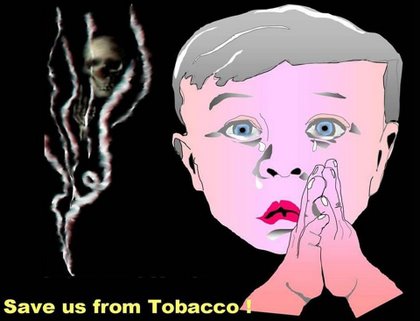 December 13, 2010 - Children living in apartments are exposed to secondhand smoke (shs, involuntary smoking, passive smoking, environmental tobacco smoke, ets, sidestream smoke) even when no one smokes inside their own unit. This study, released online today by the journal Pediatrics, strongly suggests that housing type contributes to children's exposure to tobacco smoke, despite the best intentions of parents.
December 13, 2010 - Children living in apartments are exposed to secondhand smoke (shs, involuntary smoking, passive smoking, environmental tobacco smoke, ets, sidestream smoke) even when no one smokes inside their own unit. This study, released online today by the journal Pediatrics, strongly suggests that housing type contributes to children's exposure to tobacco smoke, despite the best intentions of parents.
Previous news brief:
May 3, 2010 - Children - apartments - parents do not smoke but still exposed to secondhand smoke..
The U.S. surgeon general has said that there is no safe level of exposure to tobacco smoke. Children exposed to secondhand tobacco smoke are at greater risk for a variety of illnesses, such as respiratory infections, asthma and sudden infant death syndrome. (Office of the Surgeon General: There is No Risk-Free Level of Exposure to Secondhand Smoke..)
This new study from the University of Rochester Medical Center, MassGeneral Hospital for Children and the American Academy of Pediatrics' Julius B. Richmond Center for Excellence is the first to show significant evidence of increased tobacco smoke exposure in the blood of children who live in multi-unit housing. It will appear in the January 2011 issue of Pediatrics.
In this study, researchers measured blood levels of cotinine, a chemical commonly used to test for tobacco exposure. Overall, using the most sensitive cutoff for tobacco smoke exposure, more than 84 percent of children in multi-unit housing had been exposed to tobacco smoke, compared to almost 80 percent of children living in attached houses and 70 percent of children in detached houses. At every cutoff level of cotinine, children living in apartments had higher rates of exposure.
"Parents try so hard to protect their children from dangers, such as tobacco smoke. It's surprising to see these results and realize that too many parents have no control over whether their children are exposed to secondhand smoke in their own homes," said Karen Wilson, MD, MPH, an assistant professor of Pediatrics at the University of Rochester Medical Center's Golisano Children's Hospital and lead author of the paper.
Controlling for other factors such as poverty and age, children living in apartments had an increase in cotinine of 45 percent over those living in detached houses. While some of the tobacco exposure may have come from family members who only smoke outside, but carry in tobacco residue on their clothes, study authors suggest this is unlikely to explain all of the difference since there are many more exposed children than adult smokers. Instead they conclude tobacco smoke may have seeped through walls or shared ventilation systems. Earlier studies have shown that tobacco smoke contaminates non-smoking units of multi-unit dwellings.
References: Study: 99% of Children Living in Apartments May Be Exposed to Secondhand Smoke by Alice Park, Healthland.Time.com, 12/13/2010; Apartment-dwelling children in nonsmoking units still exposed, PhysOrg.com, 12/13/2010; Apartment-Dwelling Children in Nonsmoking Units Still Exposed New data support movement towards smoke-free multi-unit housing, University of Rochester School of Medicine Newsroom, 12/13/2010.
Bringing the World of Tobacco Control closer together..
Study: 99% of Children Living in Apartments May Be Exposed to Secondhand Smoke..
Subscribe to:
Post Comments (Atom)


To Provide Public Awareness
Purpose
About Us
Contact Us
2008 HIGHLIGHTS
TOPIX PAPERS - 2008 & 2009..
Archive
-
▼
2010 (1530)
-
▼
12/12 - 12/19 (30)
- Germany - tobacco taxes to increase in May 2011..
- King County, Washington - bans the public use of ...
- Ireland - Office of Tobacco Control to be dissolv...
- Leduc, Alberta , Canada - bans smoking in cars wi...
- Altria Group Inc. - new senior management stru...
- Ukraine - draft law introduced to ban the sale ...
- Wisconsin - after smoking ban air quality in bars ...
- Massachusetts - Lorillard has to pay punitive dam...
- Changes in Cigarette Prices May Affect Alcohol Co...
- South Korean tobacco company KT&G signs deal to s...
- New York City - suing tobacco company in Washingt...
- BAT - number of regions in management structure re...
- Newport Non-Menthol - how's it doing?? - results ...
- December 16, 2010 - 2nd White House Tribal Nations...
- Thailand - TTM to build a new plant to produce c...
- England - smokers blocked from routine surgery as...
- Bulgaria - PMI to introduce their own Marlboro 10-...
- Canada - federal govt will be releasing new war...
- NIDA Report: 2010 "Monitoring the Future" marijua...
- Massachusetts - Lorillard loses lawsuit - did they...
- UK - Brits to petition govt to put a stop to adult...
- Fiji - new tobacco control decree will not come ...
- Massachusetts South Coast - smoking among pregnan...
- Quezon City, Philippines - will strictly enforce...
- FDA Law Blog - e-cigarettes, D.C. Circuit Court of...
- New Zealand - cigarette display ban passes first r...
- Study: 99% of Children Living in Apartments May Be...
- Hong Kong - latest survey - proportion of smoker...
- More tobacco smoke children breath in, the more li...
- Massachusetts - if states cover tobacco cessation...
-
▼
12/12 - 12/19 (30)
© Copyright Notice: The content of this website is for information education purposes only and any newsbrief may be used only as "fair use" for information/education purposes with permission of the authors and providing that original references and associated reference links are included in HTML format.
0 comments:
Post a Comment